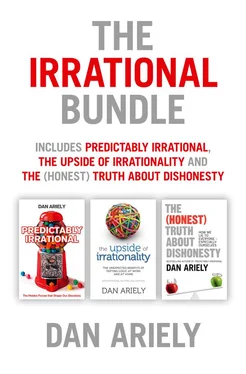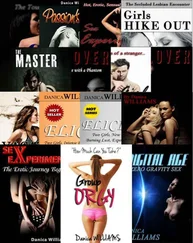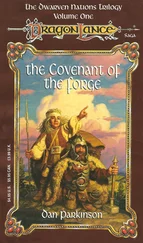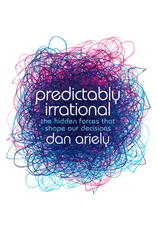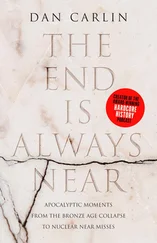Dan Ariely - The Irrational Bundle
Здесь есть возможность читать онлайн «Dan Ariely - The Irrational Bundle» — ознакомительный отрывок электронной книги совершенно бесплатно, а после прочтения отрывка купить полную версию. В некоторых случаях можно слушать аудио, скачать через торрент в формате fb2 и присутствует краткое содержание. Жанр: unrecognised, на английском языке. Описание произведения, (предисловие) а так же отзывы посетителей доступны на портале библиотеки ЛибКат.
- Название:The Irrational Bundle
- Автор:
- Жанр:
- Год:неизвестен
- ISBN:нет данных
- Рейтинг книги:3 / 5. Голосов: 1
-
Избранное:Добавить в избранное
- Отзывы:
-
Ваша оценка:
- 60
- 1
- 2
- 3
- 4
- 5
The Irrational Bundle: краткое содержание, описание и аннотация
Предлагаем к чтению аннотацию, описание, краткое содержание или предисловие (зависит от того, что написал сам автор книги «The Irrational Bundle»). Если вы не нашли необходимую информацию о книге — напишите в комментариях, мы постараемся отыскать её.
The Irrational Bundle — читать онлайн ознакомительный отрывок
Ниже представлен текст книги, разбитый по страницам. Система сохранения места последней прочитанной страницы, позволяет с удобством читать онлайн бесплатно книгу «The Irrational Bundle», без необходимости каждый раз заново искать на чём Вы остановились. Поставьте закладку, и сможете в любой момент перейти на страницу, на которой закончили чтение.
Интервал:
Закладка:
Once again, the participants typed in yes or no. Then we asked them for real bids: “How much would it take for you to listen to this again?” At this point, they had a history with three anchors: the first one they encountered in the experiment (either 10 cents or 90 cents), the second one (50 cents), and the most recent one (either 90 cents or 10 cents). Which one of these would have the largest influence on the price they demanded to listen to the sound?
Again, it was as if our participants’ minds told them, “If I listened to the first sound for x cents, and listened to the second sound for x cents as well, then I can surely do this one for x cents, too!” And that’s what they did. Those who had first encountered the 10-cent anchor accepted low prices, even after 90 cents was suggested as the anchor. On the other hand, those who had first encountered the 90-cent anchor kept on demanding much higher prices, regardless of the anchors that followed.
What did we show? That our first decisions resonate over a long sequence of decisions. First impressions are important, whether they involve remembering that our first DVD player cost much more than such players cost today (and realizing that, in comparison, the current prices are a steal) or remembering that gas was once a dollar a gallon, which makes every trip to the gas station a painful experience. In all these cases the random, and not so random, anchors that we encountered along the way and were swayed by remain with us long after the initial decision itself.
NOW THAT WE know we behave like goslings, it is important to understand the process by which our first decisions translate into long-term habits. To illustrate this process, consider this example. You’re walking past a restaurant, and you see two people standing in line, waiting to get in. “This must be a good restaurant,” you think to yourself. “People are standing in line.” So you stand behind these people. Another person walks by. He sees three people standing in line and thinks, “This must be a fantastic restaurant,” and joins the line. Others join. We call this type of behavior herding. It happens when we assume that something is good (or bad) on the basis of other people’s previous behavior, and our own actions follow suit.
But there’s also another kind of herding, one that we call self-herding. This happens when we believe something is good (or bad) on the basis of our own previous behavior. Essentially, once we become the first person in line at the restaurant, we begin to line up behind ourself in subsequent experiences. Does that make sense? Let me explain.
Recall your first introduction to Starbucks, perhaps several years ago. (I assume that nearly everyone has had this experience, since Starbucks sits on every corner in America.) You are sleepy and in desperate need of a liquid energy boost as you embark on an errand one afternoon. You glance through the windows at Starbucks and walk in. The prices of the coffee are a shock—you’ve been blissfully drinking the brew at Dunkin’ Donuts for years. But since you have walked in and are now curious about what coffee at this price might taste like, you surprise yourself: you buy a small coffee, enjoy its taste and its effect on you, and walk out.
The following week you walk by Starbucks again. Should you go in? The ideal decision-making process should take into account the quality of the coffee (Starbucks versus Dunkin’ Donuts); the prices at the two places; and, of course, the cost (or value) of walking a few more blocks to get to Dunkin’ Donuts. This is a complex computation—so instead, you resort to the simple approach: “I went to Starbucks before, and I enjoyed myself and the coffee, so this must be a good decision for me.” So you walk in and get another small cup of coffee.
In doing so, you just became the second person in line, standing behind yourself. A few days later, you again walk by Starbucks and this time, you vividly remember your past decisions and act on them again—voilà! You become the third person in line, standing behind yourself. As the weeks pass, you enter again and again and every time, you feel more strongly that you are acting on the basis of your preferences. Buying coffee at Starbucks has become a habit with you.
BUT THE STORY doesn’t end there. Now that you have gotten used to paying more for coffee, and have bumped yourself up onto a new curve of consumption, other changes also become simpler. Perhaps you will now move up from the small cup for $2.20 to the medium size for $3.50 or to the Venti for $4.15. Even though you don’t know how you got into this price bracket in the first place, moving to a larger coffee at a relatively greater price seems pretty logical. So is a lateral move to other offerings at Starbucks: Caffè Americano, Caffè Misto, Macchiato, and Frappuccino, for instance.
If you stopped to think about this, it would not be clear whether you should be spending all this money on coffee at Starbucks instead of getting cheaper coffee at Dunkin’ Donuts or even free coffee at the office. But you don’t think about these trade-offs anymore. You’ve already made this decision many times in the past, so you now assume that this is the way you want to spend your money. You’ve herded yourself—lining up behind your initial experience at Starbucks—and now you’re part of the crowd.
HOWEVER, THERE IS something odd in this story. If anchoring is based on our initial decisions, how did Starbucks manage to become an initial decision in the first place? In other words, if we were previously anchored to the prices at Dunkin’ Donuts, how did we move our anchor to Starbucks? This is where it gets really interesting.
When Howard Shultz created Starbucks, he was as intuitive a businessman as Salvador Assael. He worked diligently to separate Starbucks from other coffee shops, not through price but through ambience. Accordingly, he designed Starbucks from the very beginning to feel like a continental coffeehouse.
The early shops were fragrant with the smell of roasted beans (and better-quality roasted beans than those at Dunkin’ Donuts). They sold fancy French coffee presses. The showcases presented alluring snacks—almond croissants, biscotti, raspberry custard pastries, and others. Whereas Dunkin’ Donuts had small, medium, and large coffees, Starbucks offered Short, Tall, Grande, and Venti, as well as drinks with high-pedigree names like Caffè Americano, Caffè Misto, Macchiato, and Frappuccino. Starbucks did everything in its power, in other words, to make the experience feel different—so different that we would not use the prices at Dunkin’ Donuts as an anchor, but instead would be open to the new anchor that Starbucks was preparing for us. And that, to a great extent, is how Starbucks succeeded.
GEORGE, DRAZEN, AND I were so excited with the experiments on coherent arbitrariness that we decided to push the idea one step farther. This time, we had a different twist to explore.
Do you remember the famous episode in The Adventures of Tom Sawyer, the one in which Tom turned the whitewashing of Aunt Polly’s fence into an exercise in manipulating his friends? As I’m sure you recall, Tom applied the paint with gusto, pretending to enjoy the job. “Do you call this work?” Tom told his friends. “Does a boy get a chance to whitewash a fence every day?” Armed with this new “information,” his friends discovered the joys of whitewashing a fence. Before long, Tom’s friends were not only paying him for the privilege, but deriving real pleasure from the task—a win-win outcome if there ever was one.
From our perspective, Tom transformed a negative experience to a positive one—he transformed a situation in which compensation was required to one in which people (Tom’s friends) would pay to get in on the fun. Could we do the same? We thought we’d give it a try.
Читать дальшеИнтервал:
Закладка:
Похожие книги на «The Irrational Bundle»
Представляем Вашему вниманию похожие книги на «The Irrational Bundle» списком для выбора. Мы отобрали схожую по названию и смыслу литературу в надежде предоставить читателям больше вариантов отыскать новые, интересные, ещё непрочитанные произведения.
Обсуждение, отзывы о книге «The Irrational Bundle» и просто собственные мнения читателей. Оставьте ваши комментарии, напишите, что Вы думаете о произведении, его смысле или главных героях. Укажите что конкретно понравилось, а что нет, и почему Вы так считаете.
